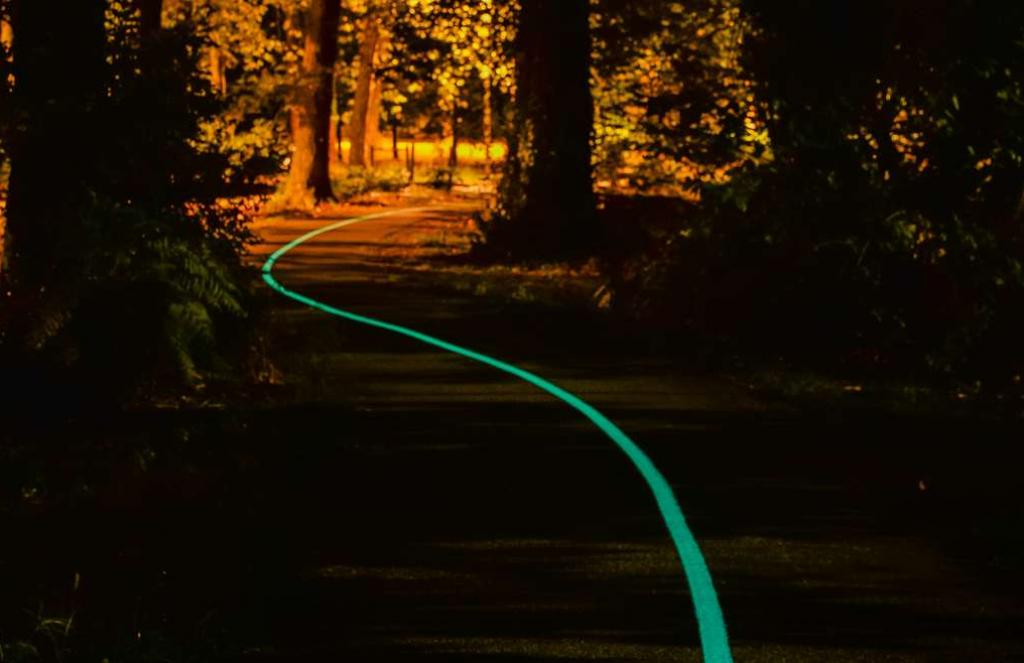Thessaloniki gets ready for its metro launch in November
The underground rapid transit lines have been under construction for almost two decades due to various project delays
 TheMayor.EU logo
TheMayor.EU logo 
The phosphorescent paint invented contains pigments that light up the road up to 100 meters, Source: Olikrom
They might be an eco-friendly solution to improve the safety of bikers
Following Pessac and other local governments in France, in April, Nancy became the latest one to experiment with an innovation in cycling infrastructure: phosphorescent marking of cycling paths. The Metropolis of Nancy announced earlier last month that they have invested in a phosphorescent paint delimiting paths along the riverbanks.
A much cheaper alternative than lampposts, this solution might also prove to be better for the natural environment, while still ensuring its main function – to navigate cyclists along the safe path.
As part of its cycling policy and in order to improve cycling conditions, the Metropolis of Nancy is currently experimenting with new phosphorescent ground signs between rue des Tiercelins and boulevard Charles III, along the canal in Nancy. The objective is to allow cyclists to easily follow cycling routes in poorly lit areas.
In particular, this phosphorescent paint makes it possible to materialize the lateral bands and the edges of the canal. The paint can shine for up to 10 hours.
According to the metropolitan authorities, painting the paths with phosphorescent paint is also much cheaper than installing lampposts for long distances and maintaining electricity. It should be noted, however, that the marks are not capable of illuminating the paths, so cyclists should still wear light equipment.
The sustainable side to the new solution is not only the fact that it does not consume any electricity (and requires less maintenance) and that it does not contribute to carbon emissions. On top of this, it also does not contribute to light pollution. The latter refers to the excessive amount of light in cities, especially at night, which confuses nocturnal animals and might be detrimental to biodiversity.
The solution has been offered by the French company Olikrom and is currently in a test phase. Should the experiment prove successful, it might be extended to other city areas where cycling paths are not sufficiently lit.

The underground rapid transit lines have been under construction for almost two decades due to various project delays

Now you can get your wine in Talence by paying directly in Bitcoin

That’s because the state has to spend money on updating the railway infrastructure rather than subsidizing the cost of the popular pass

Rethinking renewable energy sources for the urban landscape

The examples, compiled by Beyond Fossil Fuels, can inform and inspire communities and entrepreneurs that still feel trepidation at the prospect of energy transition

Now you can get your wine in Talence by paying directly in Bitcoin

The 10th European Conference on Sustainable Cities and Towns (ESCT) sets the stage for stronger cooperation between the EU, national and local level to fast track Europe's transition to climate neutrality.

At least, that’s the promise made by the mayor of Paris, Anne Hidalgo

The underground rapid transit lines have been under construction for almost two decades due to various project delays

At least, that’s the promise made by the mayor of Paris, Anne Hidalgo

Hostal de Pinós is located in the geographical centre of the autonomous region

Despite its church-y name, the district has long been known as the hangout spot for the artsy crowds

Urban dwellers across the EU are having a say in making their surroundings friendlier to people and the environment.

Forests in the EU can help green the European construction industry and bolster a continent-wide push for architectural improvements.

Apply by 10 November and do your part for the transformation of European public spaces

An interview with the Mayor of a Polish city that seeks to reinvent itself

An interview with the newly elected ICLEI President and Mayor of Malmö

A conversation with the Mayor of Lisbon about the spirit and dimensions of innovation present in the Portuguese capital














